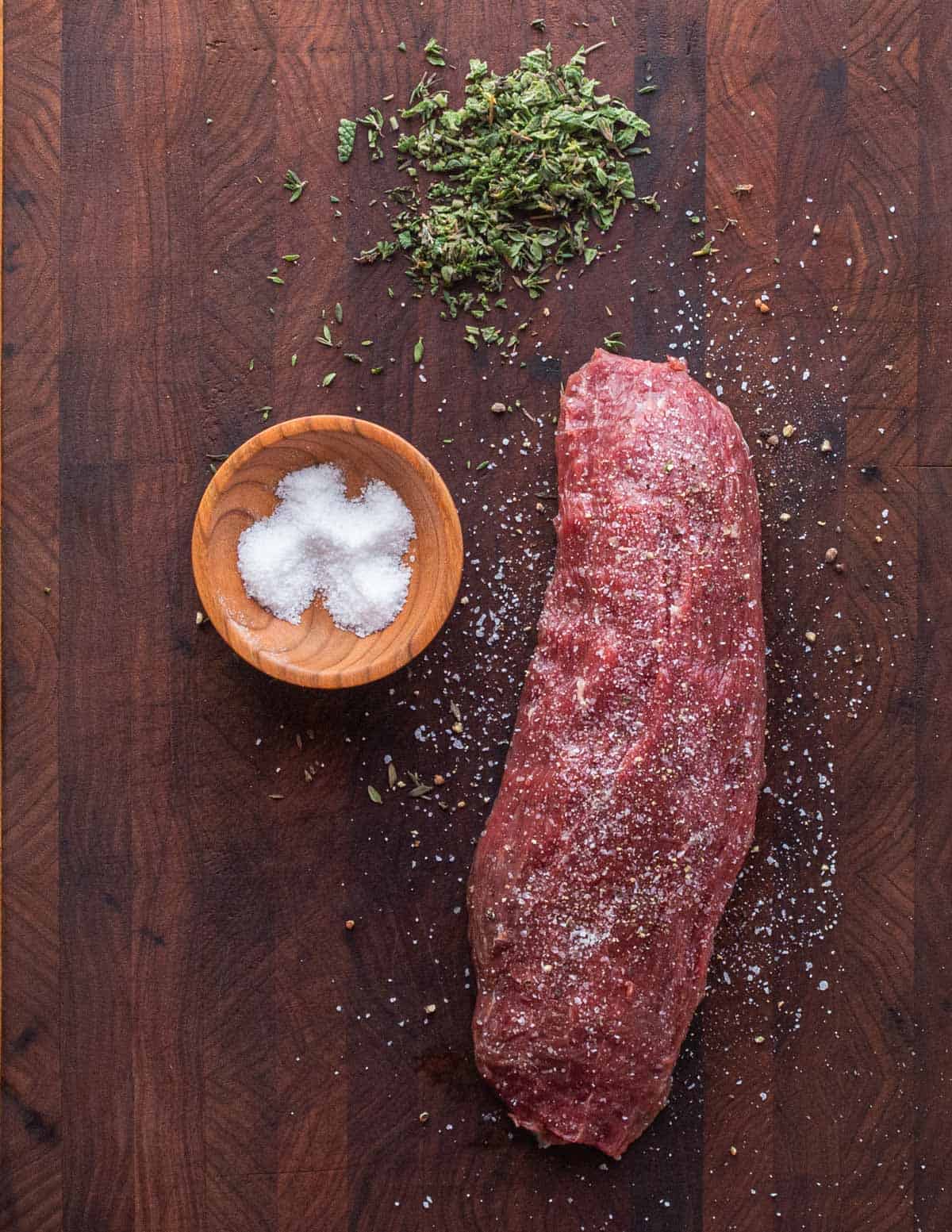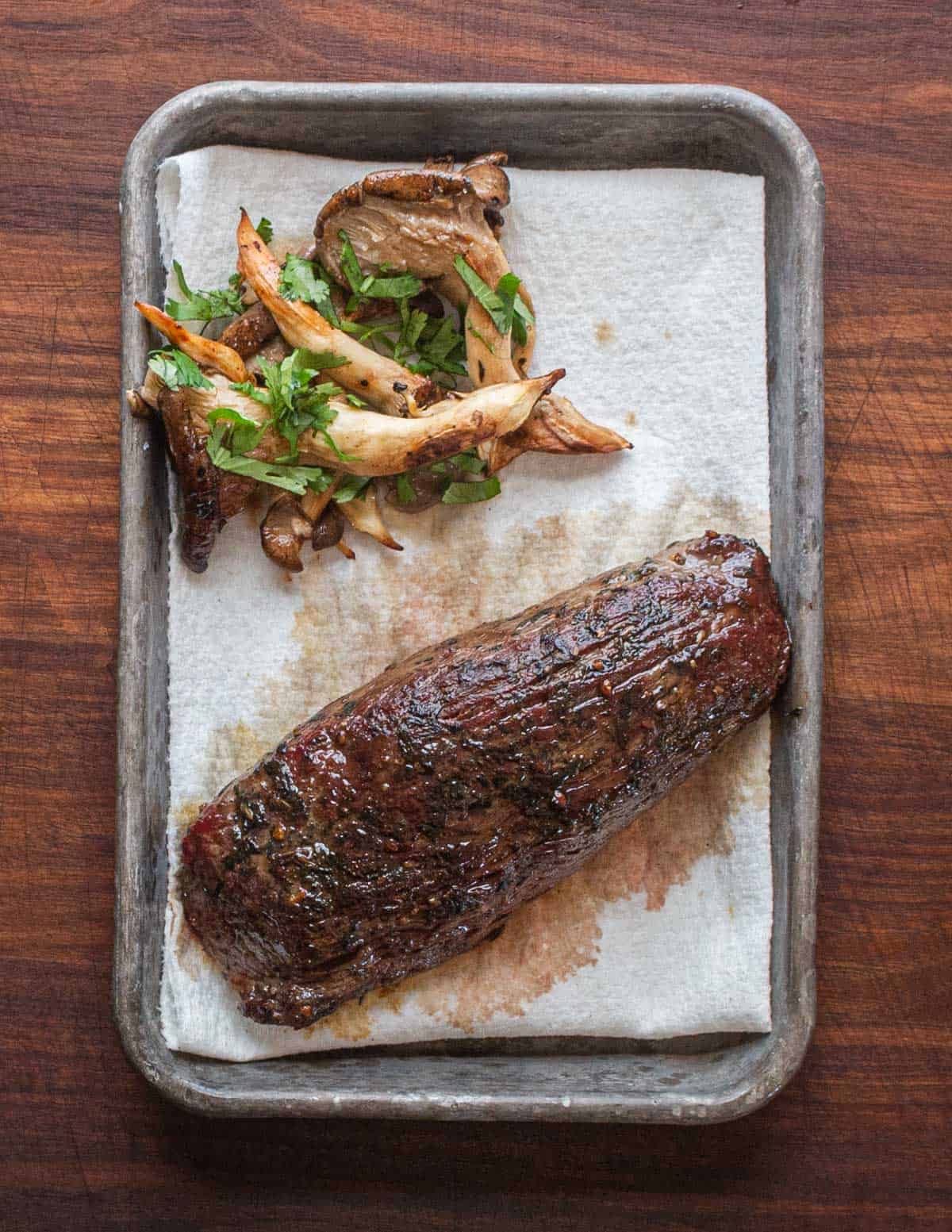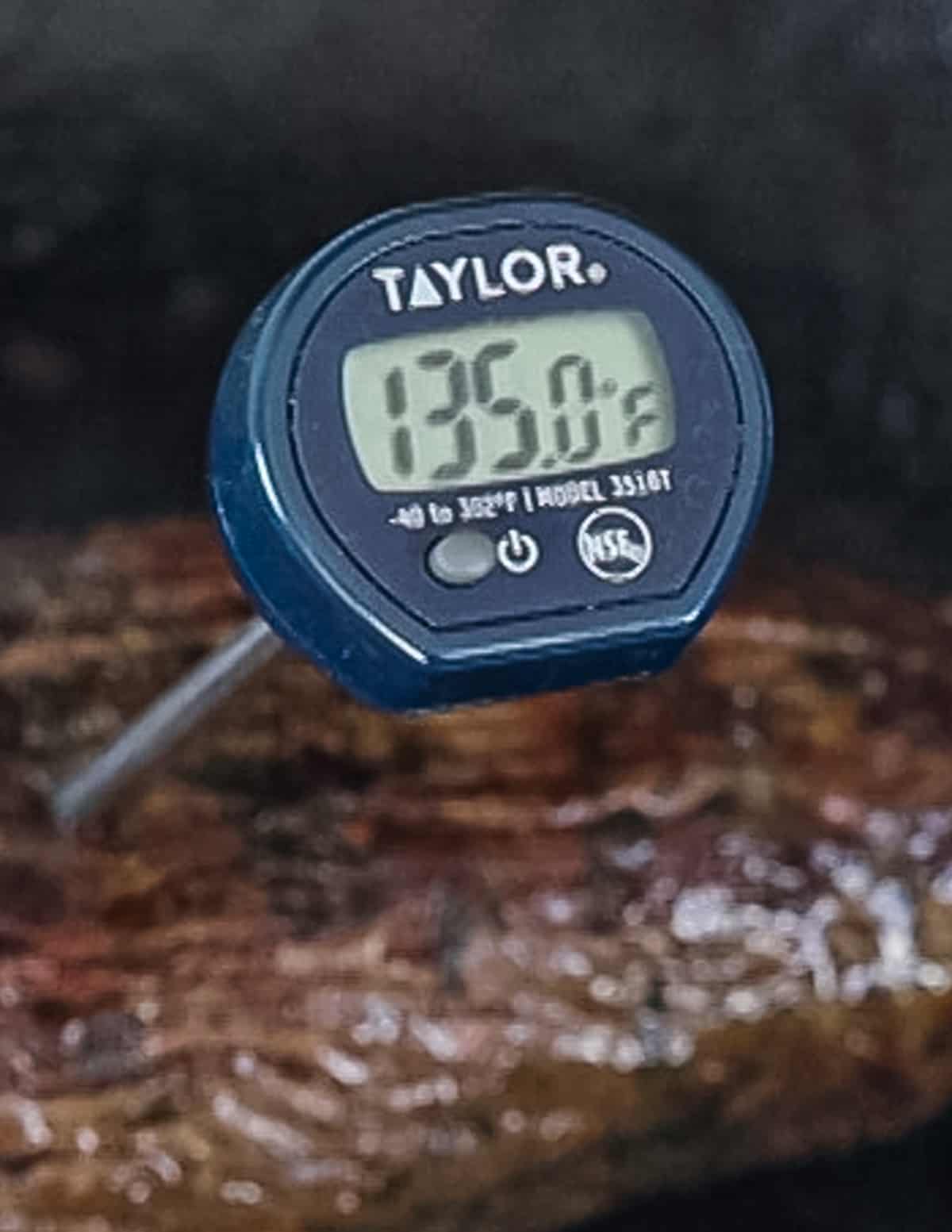A chef secret for many years, the teres major beef steak (also known as the oyster steak) is an underused cut of beef sometimes used as a substitute for beef tenderloin. If you like hanger steak, flat irons, bavette, and other "butcher steaks" you're going to love the teres major.

I served these steaks for years in restaurants, and there's a fun urban legend attached to them. Story goes during the 90's, the price of filet mignon went up, a lot.
Faced with rising food cost, a few chefs in the Twin Cities started serving petite tender steaks cut from teres major without changing the name or price on the menu. I consider the accounts anecdotal-either way it should tell you this is one tender cut of beef.
What is Teres Major Steak?
The teres major muscle is a lean cut of beef from the chuck section of a cow. It's located right below the front leg and is mostly known only by skilled butchers. Other names for the cut are the shoulder tender, shoulder filet steak, teres major tenderloin and teres filet.

Roughly the size of a pork tenderloin, it's the second or third most tender cut, next to tenderloin and ribeye. It takes its name from the same muscle of the human anatomy.
The teres major has much more flavor than a tenderloin as it comes from a heavily used, active muscle. This means it gets more blood flow, which helps develop complex, rich beefy flavor with hints of iron like a hanger steak. The increased blood flow also adds some complexity to cooking (specifically resting) I'll go over in the next section.
Do You Have to Trim a Teres Major Steak?
One of the most important things to keep in mind is that the teres major may need to be trimmed before cooking. Teres majors sold to restaurants generally don't have the silver skin removed, which covers a large portion of the muscle. If you order some from a local butcher shop like I do they may come mostly trimmed, but may still have some silver skin or sinew that should be trimmed off.


How to Cook Teres Major Steak
Like any good steak, the teres major doesn't need much. A little salt, pepper and herbs are all you need. You can grill the steaks or sear them in a pan, just like a tenderloin. I think the best way to cook teres major is to dry brine the meat, seasoning with salt, pepper and fresh herbs overnight and wrapping in cling film before cooking.
The images below illustrate the teres major marinade: salting and seasoning the meat with salt, pepper and herbs before wrapping tightly in cling film and refrigerating overnight.




A cooked teres major must be allowed to rest for it to be the most tender. If not properly rested, the steaks will give off much more juice than most other steaks. After resting, it's sliced against the grain before serving.



Chef's Tips
- With the increased blood flow the muscle receives, this cut takes much longer to rest after cooking than other cuts of beef-around twice as long. An 8 oz steak should be rested in a warm place for about 15 minutes before slicing for the best result.
- The teres major is best medium rare or medium. The temperature you cook the meat to is important, and you need to keep in mind the steak will raise 10 degrees farenhieght after cooking as it rests.
- One of the best things you can serve with a teres major is a simple compound butter, like maitre d'hotel. Ramp butter, black truffle butter, and mushroom butter are excellent choices too.
- Each steak is usually about 8 oz. For a modest serving, one steak can serve two people. You can also cut each steak into small steaks or teres major medallions roughly 3-4 oz each.


This means for a medium rare I cook the steak to 130 F, and 135 for medium. I like some steaks rare, but not the shoulder tenderloin. The picture above shows the difference in temperature before and after resting.
Related Posts
Venison Tenderloin Crusted with Dried Morels
Marinated Teres Major Steak
Equipment
- 1 heavy cast iron pan or grill for cooking the steak
- 1 digital thermometer
Ingredients
- 2 8oz Teres Major Steaks
- kosher salt and pepper roughly 1 teaspoon of salt
- 1 tablespoon mixed herbs, such as rosemary, sage and thyme finely chopped
- 2 teaspoons cooking oil
Instructions
Trim the steaks
- Inspect the steaks for any remaining silver skin and remove any that you see.
Dry brine the steaks
- Season the steaks with the salt and pepper.
- Next, sprinkle the herbs over both sides of the steak, rolling them around and pressing to help them adhere.
- Wrap the steaks in cling film and refrigerate overnight.
Pan-seared teres major steaks
- Bring the steaks to room temperature. Heat the oil in a heavy cast iron or similar pan. Add the steaks and cook until well browned on both sides. Use tongs to pick up the steak and brown the thinner sides.
- If you don't have a hood vent, you can pan roast the steaks in the oven, flipping them occasionally.
Grilled teres major steak
- Heat a grill (preferably a wood fire) until the coals are ready and there aren't visible flames. Grill the steaks, taking your time brown all of the sides.
Rest the Steaks
- When the steaks reach your desired temperature (130-135 F) remove them to a plate lined with a paper towel and allow to rest in a warm place such as near the oven vent, or in a warm oven with the heat turned off. Rest the steaks for 15 minutes before slicing and serving
Video
Notes
What to Serve With Teres Major Steaks
This is one of the best steaks for a summertime grill out. Serve it with your favorite accompaniments like fresh seasonal vegetables, sauteed mushrooms, or a compound butter like ramp butter or black truffle butter.Nutrition
FAQ
Fresh from the cow, the teres major is covered in layers of silverskin on all sides which should be removed using a paring knife. If you buy them from a butcher, they may be partially trimmed, but often have some sinew remaining that should be removed.
Teres major are a rare steak to see at a butcher, but most butchers can order them. If you're in the Twin Cities, France 44 keeps them in stock.
Yes, as far as steaks go, the teres major is the second or third most tender cut on a cow. It's not as tender as tenderloin, but it makes up for it with a much richer beef flavor.
The steaks should be grilled slightly under temperature as they need a longer time to rest than other steaks since they're a very active muscle. For medium rare, cook them to 130F. For medium, cook to 135. Rest the steaks for 15 minutes before slicing.
They're much cheaper and typically less than half the price of tenderloin, around $8/lb.


Dan
A place by me sells a Wagyu version of this cut at $19 a pound. Tried it for the very first time last night. It weighed about one pound. Prepared it kind of like a steak au poivre, but with mushrooms, as follows. Dry brined beef with lots of coarse ground pepper, and salt. Cooked it in a very hot cast iron pan until very brown on all sides. Rested meat about ten minutes. While meat was resting, cooked some sliced baby portabella mushrooms in butter in a saute pan till brown and nice (with a bit of salt and pepper). Put meat back in warm pan, added 1/2 cup cognac (could use any brandy), flame it, then remove meat, add 1/2 cup cream, add in mushrooms, and reduce by half. Sliced the beef, served with the mushroom/brandy/cream sauce. Served with homemade gnocchi. It was amazing. Great meaty flavor, and nice texture, tender, but not as much as a tenderloin.
Alan Bergo
Nice work. Wagyu teres sounds great.
Jacek
Just prepared a Teres Major steak for the Polish version of Steak Tatar; Chilled it in the freezer so it was easier to cut into 1/8" cubes, seasoned with olive oil, light Maggi, sea salt, pepper and served with raw quail egg on top -'Pirate' style, with capers, cornischon, and chopped shallots. Chased down with a shot of ice cold vodka infused with horseradish root! Heaven.
Alan Bergo
That sounds great.
Elissa
Oh my gosh, this is excellent. It is a beautiful cut of meat when you cook it right so thank you for the guidance. I can’t wait to grill tonight and this totally rhymed.
Alan Bergo
Thanks Elissa. I also enjoy the flavor of teres major 🙂
Jeff O
Thanks for turning me onto this cut! I called my butcher, they got them in a few days and the price was right. Grate flavor and next time i'm buying some for the freezer to. Perfect steak for grilling season.